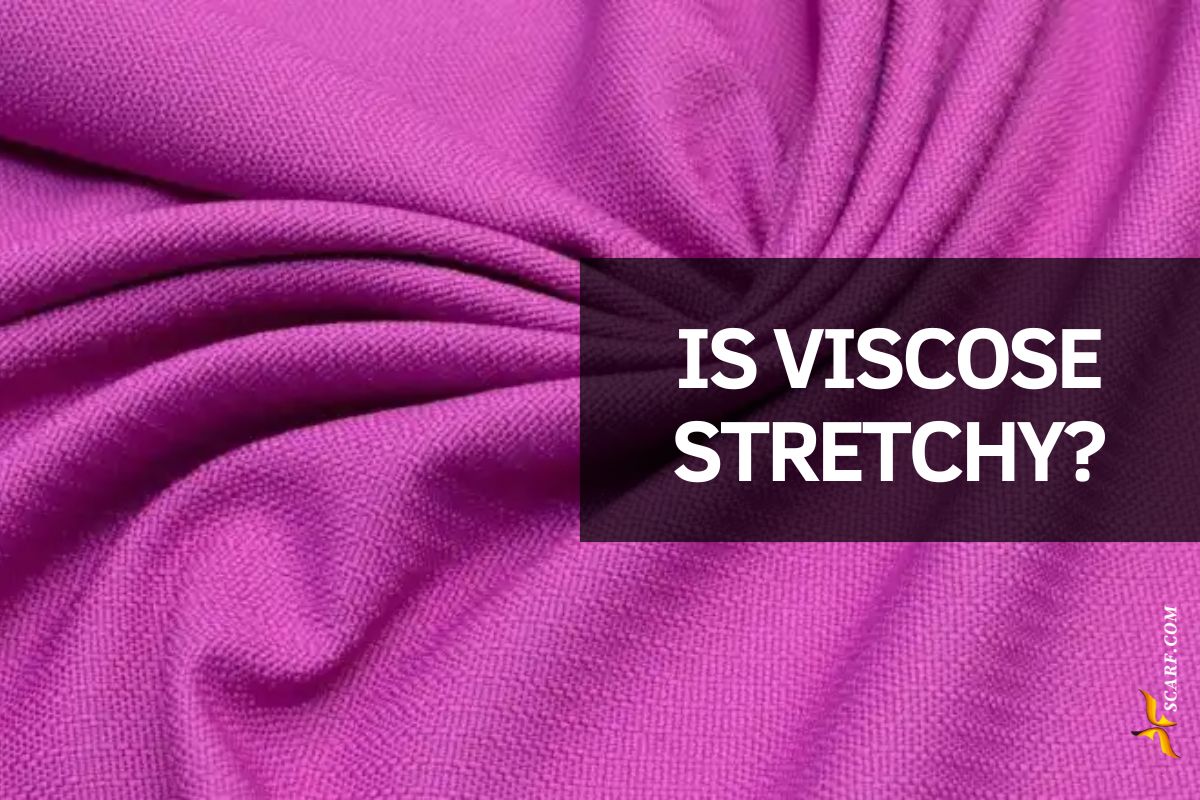common question arises: is viscose stretchy? This concern matters deeply when selecting clothing that offers both comfort and a flattering fit.
Understanding the nature of viscose helps in making thoughtful choices and maintaining garments with care.
Our discussion covers the stretch properties of viscose and shares practical advice for its upkeep. Learning how this fabric behaves can prevent damage and extend the life of what you wear.
Short answer: Is Viscose Stretchy?
No. Pure viscose lacks natural elasticity. While it offers gentle give over time, it doesn’t stretch like spandex or wool. This semi-synthetic fabric prioritizes drape and softness over stretchiness.
- Short answer: Is Viscose Stretchy?
- What Is Viscose?
- Why Viscose Lacks Stretch
- How Viscose Behaves When Blended
- The Problem with Viscose and Water
- Daily Care and Washing Tips
- Storing Your Viscose Clothing
- Repairing Stretched-Out Viscose
- Viscose vs. Other Fibers
- FAQ
- 1. Can you stretch viscose fabric if it’s too small?
- 2. Does viscose shrink more than cotton?
- 3. Is viscose a good fabric for summer?
- 4. Why does my viscose clothing feel stiff after washing?
- 5. Can I use fabric softener on viscose?
- 6. How can I tell if a garment is 100% viscose or a blend?
- 7. Is viscose sustainable?
- 8. What’s the difference between viscose and rayon?
- 9. Can viscose be altered by a tailor?
- 10. My viscose garment snagged. What can I do?
What Is Viscose?
Viscose belongs to the family of semi-synthetic fibers. It originates from natural cellulose, typically sourced from wood pulp or cotton. Many refer to it as “artificial silk” or “rayon”.
The fabric is loved for being soft and smooth against the skin. It is both lightweight and breathable, draping elegantly on the body. These qualities make it popular for dresses and blouses. Viscose also boasts high absorbency, surpassing even cotton in this regard. It feels especially comfortable in warm weather.
Production involves chemical treatment, though its foundation remains natural.
Pure viscose possesses minimal natural stretch. It does not offer elasticity like spandex or wool. With use, viscose may stretch out over time, particularly without proper care.
You might notice slight give in a viscose garment, but it isn’t designed for stretch.
Why Viscose Lacks Stretch
The molecular arrangement of viscose explains its limited stretch. Its fibers are inherently rigid, lacking the coils seen in elastic materials. Under pressure, fibers may break or deform rather than stretch. This low elasticity defines the fabric. Garments made from 100% viscose can feel restrictive—they don’t move with your body. This quality sets it apart from many other textiles.
How Viscose Behaves When Blended
Blending viscose with other fibers enhances its performance. It can introduce stretch and improve durability. Popular blends include:
- Viscose with Spandex (Elastane): A small percentage of spandex (around 5-10%) offers noticeable stretch and recovery. This combination supports comfort and a snug fit.
- Viscose with Polyester: Polyester contributes strength and shape retention. It helps the fabric resist wrinkles and last longer.
- Viscose with Cotton: This mix pairs the softness of viscose with the stability of cotton. Breathability improves, though stretch remains limited.
Always review the garment’s label for blend information. It reveals what to expect in terms of fit and care.
The Problem with Viscose and Water
Water greatly influences viscose. The fabric’s wet strength is low; it can lose up to half its strength when wet. This makes washing a delicate task. Fibers absorb water and expand, which might lead to permanent stretching. Improper drying often causes significant shrinkage. Handling with care is non-negotiable.
Daily Care and Washing Tips
Caring for viscose demands attention. Proper methods prevent stretching and damage.
1. Decoding the Label
Your first step is to read the care label. Some viscose blends allow machine washing. Pure viscose usually needs hand washing or dry cleaning.
2. Hand Washing Viscose
Hand washing is safest.
- Use cold or lukewarm water.
- Select a mild detergent with a neutral pH.
- Limit soaking to 10-15 minutes.
- Gently swirl the water. Avoid wringing or twisting.
3. Machine Washing Viscose
If machine washing is permitted:
- Choose the gentlest cycle available.
- Use cold water.
- Place the item in a protective mesh bag.
- Never use bleach.
4. Drying Viscose Correctly
Avoid machine dryers. Heat and motion cause shrinkage and harm.
- After washing, roll the garment in a towel to remove moisture.
- Lay it flat on a dry towel, reshaping as needed.
- Skip hanging—it can lead to stretching.
- Dry away from direct sunlight to prevent fading.
5. Ironing Viscose Garments
Viscose wrinkles but responds well to ironing.
- Verify the label for temperature guidelines.
- Iron while the material is slightly damp.
- Use low to medium heat.
- Iron inside-out or use a pressing cloth for protection.
Storing Your Viscose Clothing
Storage impacts longevity.
- Fold and store in drawers or shelves.
- Limit hanging to avoid misshaping.
- Pick a cool, dry place for storage to prevent mildew.
Repairing Stretched-Out Viscose
Did your viscose garment stretch? Try this:
- Wash it gently.
- While damp, lay it flat and reshape manually.
- Let it air dry. Some shrinkage may occur.
For major changes, consult a professional tailor.
Viscose vs. Other Fibers
- Viscose vs. Cotton: Cotton offers greater dry strength and easier care. Viscose feels softer and drapes more fluidly.
- Viscose vs. Polyester: Polyester is stronger, more resistant to stretching and shrinking. It is less breathable than viscose.
- Viscose vs. Modal: Modal, a rayon variant, is stronger when wet and has a softer texture.
- Viscose vs. Lyocell (Tencel™): Lyocell is produced eco-consciously. It is stronger dry and wet, with better elasticity and wrinkle resistance.
FAQ
1. Can you stretch viscose fabric if it’s too small?
Stretching is not recommended. It risks fiber damage. Choose the correct size from the start.
2. Does viscose shrink more than cotton?
Viscose is more prone to shrinkage, especially with heat exposure.
3. Is viscose a good fabric for summer?
Absolutely. Its absorbency and breathability make it ideal for heat.
4. Why does my viscose clothing feel stiff after washing?
Stiffness may come from mineral deposits or detergent residue. A mild detergent and full rinse can help.
5. Can I use fabric softener on viscose?
It’s better to avoid softener. It can reduce absorbency and breathability.
6. How can I tell if a garment is 100% viscose or a blend?
The fabric care label provides fiber content details.
7. Is viscose sustainable?
Viscose is biodegradable, coming from natural pulp. Traditional production uses chemicals, but newer methods are greener.
8. What’s the difference between viscose and rayon?
Rayon is the general category. Viscose is the most common type. Modal and Lyocell are other rayons.
9. Can viscose be altered by a tailor?
A skilled tailor can alter viscose, handling its delicacy with expertise.
10. My viscose garment snagged. What can I do?
Small snags can be gently eased to the reverse side. For larger damage, seek professional repair.
We specialize in customizing scarves, hats, clothing and accessories. Please feel free to contact us.



